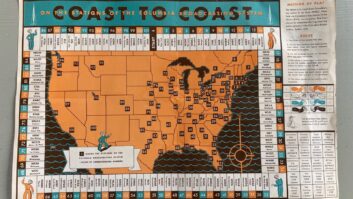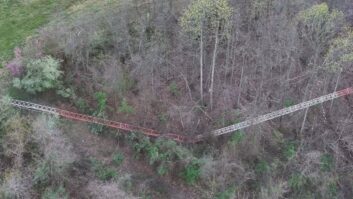As the Industry Considers IBOC Datacasting, Uncertainty Reigns
Last time we considered the general prospects of radio datacasting. This time we’ll look more closely at HD Radio’s datacasting features.
First, note that the IBOC AM system allows only a small amount (~400 bits per second) of data to be carried, in either hybrid or all-digital modes, and this is not likely to produce significant impact for consumers or broadcasters. Therefore most of the discussion of datacasting in HD Radio involves the FM system.
As is well known by now, IBOC FM comes in three flavors, hybrid, extended hybrid and all-digital modes. The amount of ancillary data that can be carried in each mode is the result of several variables, so the answer to broadcasters’ primary question of how much data IBOC FM can carry is not a straightforward single value.
Counting the bits
One of these variables involves HD Radio’s ability to provide ancillary data in fixed and/or opportunistic forms. In the fixed case (during hybrid operation), ancillary data simply replaces some of the 96 kbps of payload that would otherwise be allocated to audio. In other words, a broadcaster could opt to reduce main program audio service to 64 kbps and use 32 kbps for a fixed data service.
(Recent subjective listening tests of the HDC codec conducted by Ibiquity showed that perceived audio quality was quite similar at 64 and 96 kbps, so such a datacasting arrangement apparently could be accomplished with little audio quality impact.)
Independent of fixed data services, IBOC FM also allows opportunistic data services, in which bits that are not needed for perceptual audio coding in a particular frame are allocated to ancillary data transmission. Naturally, the amount of data that can be carried in such a way will vary according to the audio program’s characteristics. In general terms, the less rigorous the audio signal’s coding requirements are, and the more silence the program includes, the greater the availability will be for opportunistic data transmission.
Beyond the hybrid mode, datacasting capacity projections become even more complex. In the extended hybrid mode, additional datacasting capacity of up to 50 kbps could be added, in steps that are multiples of the IBOC FM frequency partition. These partitions are the building blocks of the IBOC baseband. Each partition delivers ~12.5 kbps of digital information on 18 OFDM subcarriers (plus a reference subcarrier), occupying ~7 kHz. (Each partition is duplicated on upper and lower sidebands around the FM channel’s analog signal.) The extended hybrid mode could add one, two or four of these partitions (at the broadcaster’s option) to the 10 partitions used in the hybrid mode, thereby providing 12.5, 25 or 50 kbps of additional bandwidth.
In the all-digital FM mode, suffice it to say that overall digital capacity of an FM channel would approximately double from what the fully implemented extended hybrid mode could carry. Of course, this mode would also require shutoff of all analog subcarrier services currently used for data transmission, so the net gain in a broadcaster’s overall datacasting capacity would be somewhat tempered.
Also remember that the data rates cited above are raw information rates, and that data service payload rates (i.e., the usable signal a data service can deliver to the receiver) in any wireless data delivery system will be reduced below raw rates by the error correction and other overhead required for robustness. Data services typically require higher levels of accuracy than digital audio signals, so the amount of throughput that may be required for assignment to overhead could be substantial. Therefore net payload rates for datacasting services may be significantly less than the simple baseband analysis above indicates.
Robustness is a complex question in its own right. Unlike digital audio, in which the error-threshold performance of the single codec used is well known, datacasting could present a wide range of services (for example, file downloads vs. real-time streaming services), each with its own – and possibly quite divergent – transmission error-rate requirements. This implies that the reliable coverage area for some data services may be smaller than that of others, or of main program audio service area, of an IBOC FM station. Alternatively, it could require heavy error correction overhead to be applied to match main audio coverage for some data services, resulting in considerably reduced overall datacasting capacity.
Note that the all of the above comes from Ibiquity Digital’s proposals for its HD Radio system and other industry discussion, and it assumes that the FCC will issue rules that conform to these proposals. The FCC’s recent Further Notice of Proposed Rule Making on Digital Radio (the comment process for which is now just concluding) asked for input on datacasting, and the resulting rules that the FCC adopts will very likely include IBOC datacasting regulation.
Up in the air
Beyond these empirical issues are some deeper questions on IBOC datacasting.
First, how will the allocation of datacasting bits be controlled? It is possible that multiple data delivery services will vie for space into the datacasting bandwidth described above, and the algorithm that prioritizes this procession of data could have considerable impact on the performance of one or more of these services as received by end-users.
This is quite different than the FM subcarrier environment, in which a given service is permanently allocated a fixed piece of the FM channel’s spectrum, which the service can pack, code and modulate with bits as it sees fit. In the IBOC data world, the bits representing all audio and data signals are mapped into a single bitstream that is scrambled, interleaved and modulated onto multiple OFDM carriers by the HD Radio system. Therefore the “traffic control” or gate-keeping function of any data bandwidth-allocation system could be pivotal to a broadcaster’s IBOC data-delivery business.
Ibiquity claims to have a solution for this it calls Advanced Application Services or AAS, but it has not yet been disclosed. This has kept datacasting service providers and broadcasters in the dark about the actual capabilities of IBOC data delivery, thereby thwarting any serious planning for future services. Further, Ibiquity plans to issue a public API for datacasting application developers later this year, but this may not fully answer the prioritization questions noted above. It also might not adequately serve those providers that wished to provide proprietary services equivalent to numerous FM subcarrier data services in use today, which provide some welcome supplemental revenue to many FM broadcasters.
Absent further disclosure, it would also lock in AAS as the only platform that IBOC datacasting developers could write for. (Consider that this would include all digital radio datacasting in the all-digital IBOC FM era.) And, as noted on previous occasions, Ibiquity also may levy an additional tier of licensing fees to broadcasters for the use of AAS. While this uniformity could help stimulate datacasting application development and consumer usage, some comments in the FNPRM have suggested that the FCC should avoid specifying such a singular approach to IBOC datacasting, and allow broadcasters to choose among a marketplace of options for datacasting transport controls to best serve their data-service customers.
Another area of datacasting under discussion today is Supplemental Audio Service. Based on the interim FCC Rules, where only main-channel audio (a simulcast of the analog signal) was considered – and as reflected in Ibiquity documentation -Supplemental Audio is currently considered a data service. Apparently Ibiquity is reconsidering this, in light of the recent groundswell of interest in the Supplemental Audio concept. The IBOC FM system may be reconfigured to treat Supplemental Audio as its own service category, essentially as a variant of main program audio, and separate from actual (non-audio) data services. It also may be licensed to broadcasters in a separate tier.
Obviously there are numerous issues yet to be sorted out in the IBOC datacasting environment. The industry’s ongoing review of comments to the FCC’s FNPRM, and the FCC’s own conclusions from this process, may settle some of these matters, while others will only be clarified with experience from speculative investment. Such dabbling in digital radio datacasting may cause broadcasters to learn some lessons the hard way (it wouldn’t be the first time), but it could also prove to be a venture that pays substantial dividends. Before this process can begin, however, at least some of these fundamental questions will need to be resolved.
Next time we’ll conclude our examination of radio datacasting with a look at emerging competitive services.










